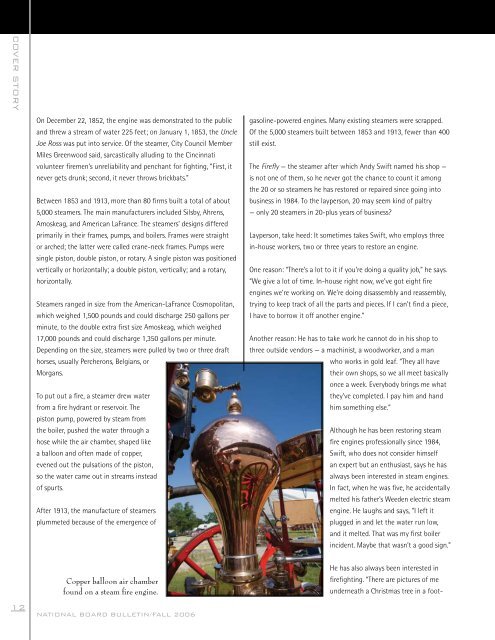bulletin - The National Board of Boiler and Pressure Vessel Inspectors
bulletin - The National Board of Boiler and Pressure Vessel Inspectors
bulletin - The National Board of Boiler and Pressure Vessel Inspectors
You also want an ePaper? Increase the reach of your titles
YUMPU automatically turns print PDFs into web optimized ePapers that Google loves.
COVER 74TH GENERAl STORY<br />
MEETING HIGHlIGHTS<br />
12<br />
On December 22, 1852, the engine was demonstrated to the public<br />
<strong>and</strong> threw a stream <strong>of</strong> water 225 feet; on January 1, 1853, the Uncle<br />
Joe Ross was put into service. Of the steamer, City Council Member<br />
Miles Greenwood said, sarcastically alluding to the Cincinnati<br />
volunteer firemen’s unreliability <strong>and</strong> penchant for fighting, “First, it<br />
never gets drunk; second, it never throws brickbats.”<br />
Between 1853 <strong>and</strong> 1913, more than 80 firms built a total <strong>of</strong> about<br />
5,000 steamers. <strong>The</strong> main manufacturers included Silsby, Ahrens,<br />
Amoskeag, <strong>and</strong> American LaFrance. <strong>The</strong> steamers’ designs differed<br />
primarily in their frames, pumps, <strong>and</strong> boilers. Frames were straight<br />
or arched; the latter were called crane-neck frames. Pumps were<br />
single piston, double piston, or rotary. A single piston was positioned<br />
vertically or horizontally; a double piston, vertically; <strong>and</strong> a rotary,<br />
horizontally.<br />
Steamers ranged in size from the American-LaFrance Cosmopolitan,<br />
which weighed 1,500 pounds <strong>and</strong> could discharge 250 gallons per<br />
minute, to the double extra first size Amoskeag, which weighed<br />
17,000 pounds <strong>and</strong> could discharge 1,350 gallons per minute.<br />
Depending on the size, steamers were pulled by two or three draft<br />
horses, usually Percherons, Belgians, or<br />
Morgans.<br />
To put out a fire, a steamer drew water<br />
from a fire hydrant or reservoir. <strong>The</strong><br />
piston pump, powered by steam from<br />
the boiler, pushed the water through a<br />
hose while the air chamber, shaped like<br />
a balloon <strong>and</strong> <strong>of</strong>ten made <strong>of</strong> copper,<br />
evened out the pulsations <strong>of</strong> the piston,<br />
so the water came out in streams instead<br />
<strong>of</strong> spurts.<br />
After 1913, the manufacture <strong>of</strong> steamers<br />
plummeted because <strong>of</strong> the emergence <strong>of</strong><br />
Copper balloon air chamber<br />
found on a steam fire engine.<br />
NATIONAl BOARD BUllETIN/FAll 2006<br />
gasoline-powered engines. Many existing steamers were scrapped.<br />
Of the 5,000 steamers built between 1853 <strong>and</strong> 1913, fewer than 400<br />
still exist.<br />
<strong>The</strong> Firefly — the steamer after which Andy Swift named his shop —<br />
is not one <strong>of</strong> them, so he never got the chance to count it among<br />
the 20 or so steamers he has restored or repaired since going into<br />
business in 1984. To the layperson, 20 may seem kind <strong>of</strong> paltry<br />
— only 20 steamers in 20-plus years <strong>of</strong> business?<br />
Layperson, take heed: It sometimes takes Swift, who employs three<br />
in-house workers, two or three years to restore an engine.<br />
One reason: “<strong>The</strong>re’s a lot to it if you’re doing a quality job,” he says.<br />
“We give a lot <strong>of</strong> time. In-house right now, we’ve got eight fire<br />
engines we’re working on. We’re doing disassembly <strong>and</strong> reassembly,<br />
trying to keep track <strong>of</strong> all the parts <strong>and</strong> pieces. If I can’t find a piece,<br />
I have to borrow it <strong>of</strong>f another engine.”<br />
Another reason: He has to take work he cannot do in his shop to<br />
three outside vendors — a machinist, a woodworker, <strong>and</strong> a man<br />
who works in gold leaf. “<strong>The</strong>y all have<br />
their own shops, so we all meet basically<br />
once a week. Everybody brings me what<br />
they’ve completed. I pay him <strong>and</strong> h<strong>and</strong><br />
him something else.”<br />
Although he has been restoring steam<br />
fire engines pr<strong>of</strong>essionally since 1984,<br />
Swift, who does not consider himself<br />
an expert but an enthusiast, says he has<br />
always been interested in steam engines.<br />
In fact, when he was five, he accidentally<br />
melted his father’s Weeden electric steam<br />
engine. He laughs <strong>and</strong> says, “I left it<br />
plugged in <strong>and</strong> let the water run low,<br />
<strong>and</strong> it melted. That was my first boiler<br />
incident. Maybe that wasn’t a good sign.”<br />
He has also always been interested in<br />
firefighting. “<strong>The</strong>re are pictures <strong>of</strong> me<br />
underneath a Christmas tree in a foot-








